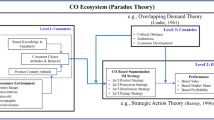Abstract
This study compares knowledge and its performance effects between Asian and Western MNEs in the People's Republic of China. It examines knowledge differences along four dimensions including technological skills, organizational capabilities, marketing knowledge, and environment familiarity between two groups. The discriminant analysis of the survey data containing 178 MNE sub-units in China suggests that Asian MNEs are inferior in technological and organizational competencies but superior in host country-specific knowledge such as marketing tactics and environmental familiarity, compared to Western counterparts. Despite such differences, knowledge in all four dimensions is found to enhance financial returns and overall performance for sample firms no matter where they come from. The logic underlying the dominance of Asian MNEs in China's FDI, from economic, cultural, and institutional perspectives, is also highlighted.
Similar content being viewed by others
REFERENCES
Adler, N.J., Campbell, N. and Laurent, A. 1989. In search of appropriate methodology: From outside the People's Republic of China looking in. Journal of International Business Studies, 20: 61–74.
Aggarwal, R. and Agmon, T. 1990. The international success of developing country firms: Role of government-directed advantage. Management International Review, 30(2): 163–180.
Anand J. and Kogut, K. 1997. Technological capabilities of countries, firm rivalry and foreign direct investment. Journal of International Business Studies, 28 (3): 445–466.
Barney, J.B. and Zajac, E.J. 1994. Competitive organizational behavior: Toward an organizationally-based theory of competitive advantage. Strategic Management Journal, 15: 5–10.
Beamish, P.W. 1993. The characteristics and Performance of joint ventures in the People's Republic of China. Journal of International Marketing, 1(2): 29–48.
Bulletin of MOFTEC 1996. Bulletin of Ministry of Foreign Trade and Economic Cooperation, People's Republic of China, No. 2.
Chandler, G.N. and Hanks, S.H. 1993. Measuring the performance of emerging business: A validation study. Journal of Business Venturing, 8: 391–408.
Chen, E.K.Y. 1990. Foreign Direct Investment in Asia. Tokyo: Asian Productivity Organization.
Chen, E.K.Y. and Wong, T.Y.C. 1994.Economic synergy — A study of two-way foreign direct investment flow between Hong Kong and Mainland China. Mimeo, Hong Kong: Center of Asian Studies, University of Hong Kong.
Collis, D.J. 1991. A resource-based analysis of global competition: The case of the bearings industry. Strategic Management Journal, 12(Summer): 49–68.
Copeland, L. and Griggs, L. 1985. Going International. New York: Random House.
Dunning, J.H. 1993. Multinational Enterprises and the Global Economy. New York: Addison Wesley.
Foreign investment in China 1997. China Foreign lnvejted Enterpises Association, No, 1: 9–16.
Ghoshal, S. 1987. Global strategy: An organizing framework. Strategic Management Journal, 8: 425–440.
Hamel, G. 1991. Competition for competence and inter-partner learning within international strategic alliances. Strategic Management Journal, 12: 83–104.
Hwang, E.R. 1987. Face and favor: The Chinese power game. American Journal of Sociology, 92(4): 35–41.
Hymer, S.H. 1979. The International Operations of National Firms: A Study of Direct Foreign Investment. Cambridge, MA: MIT Press.
Inkpen, A.C. and Beamish, P.W. 1997. Knowledge, bargaining power, and the instability of international joint ventures. Academy of Management Review, 22: 177–202.
Kao, J. 1993. The worldwide web of Chinese business. Harvard Business Review, March-April: 24–36.
Lall, S. 1983. The New Multinationals: The Spread of Third World Enterprises. Chichester: Wiley.
Lecraw, D.J. 1984. Bargaining power, ownership and profitability of subsidiaries of TNCs in developing countries. Journal of International Business Studies, 15(l): 2743.
Lecraw, D.J. 1993. Outward direct investment by Indonesian firms: Motivation and effects.
Journal of International Business Studies, Third Quarter: 589–600.
Lee, K. and Plummer, M. 1992. Competitive advantages, two-way foreign investment, and capital accumulation in Korea. Asian Economic Journal, 6: 93–114.
Linder, S.B. 1986. The Pacific Century: Economic and Political Consequences of Asian-Pacific Dynamism, Stanford, CA: Stanford University Press.
Luo, Y. 1995. Business strategy, market structure, and performance of international joint ventures: The case of joint ventures in China. Management International Review, 35(3): 241–264.
Luo, Y. 1997. Partner selection and venturing success: The case of joint ventures with firms in the People's Republic of China. Organization Science, 8(6): 648–662.
Luo, Y. 1998. Timing of investment and international expansion performance in China. Journal of International Business Studies. 29(2): 391–408.
Luo, Y. and Chen, M. 1996. Managerial implications of guanxi-based business strategies. Journal of International Management, 2(4): 293–316.
Ouchi, W.G. and Price, R.L. 1993. Hierarchies, clans, and theory 2: A new perspective on organization development. Organizational Dynamics, 21(4): 62–70.
Porter, M.E. 1990. The Competitive Advantage of Nations. New York: Wiley.
Tan, J.J. and Litschert, R.J. 1994. Environment-strategy relationship and its performance implications: An empirical study of Chinese electronics industry. Strategic Management Journal, 15: 1–20.
Vernon, R. 1979. The product cycle hypothesis in a new international environment. OBES, 255–267.
Wells, L.T. 1983. Technology and Third World Multinationals: The Rise of Foreign Investment from Developing Countries. Cambridge, Mass.: MIT Press.
Yan, A. and Gray, B. 1994. Bargaining power, management control, and performance in United States-China joint ventures: A comparative case study. Academy of Management Journal, 37(6): 1478–1517.
Yeung, H.W. 1994. Transnational corporations from Asian developing countries: Their characteristics and competitive edge. Journal of Asian Business, 10(4): 17–58.
Yeung, H.W. 1997. Cooperative strategies and Chinese business networks: A study of Hong Kong transnational corporations in the ASEAN region. In P.W. Beamish and J.P. Killing, Cooperative Strategies: Asian Pacific Perspectives. San Francisco: New Lexington Press.
Author information
Authors and Affiliations
Rights and permissions
About this article
Cite this article
Luo, Y. Dimensions of Knowledge: Comparing Asian and Western MNEs in China. Asia Pacific Journal of Management 16, 75–93 (1999). https://doi.org/10.1023/A:1015410219287
Issue Date:
DOI: https://doi.org/10.1023/A:1015410219287




